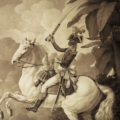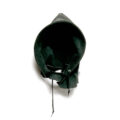What Was Before comes Back: Tess Taylor’s California Chronicles

Two years ago, when my daughter was seven, she encountered homelessness for the first time. We were visiting Seattle, where the temperate summer climate, inequality, and lack of affordable housing had attracted networks of cardboard boxes, panhandlers, and people sleeping on sidewalks. She was puzzled by the sight. Her only frame of reference was her own elaborate cardboard constructions: Jedi temples, spacecraft, and walk-in doll closets.
Finally, after we had walked several blocks, she slowed as we approached a young couple sitting cross-legged on the ground with a German shepherd, her fear of dogs trumping curiosity. A family member urged her on, and, once we were out of earshot, whispered to me, “I hate it when they do that to animals.”
I often thought of this experience while reading Tess Taylor’s latest books, Last West: Roadsongs for Dorothea Lange and Rift Zone. Both works consider Taylor’s native California, one from the perspective of Lange’s iconic travels through the state, documenting the human cost of the Great Depression, and the other from the vantage point of her hometown in the Bay Area suburbs, from prehistory to the present.
While each book has its discreet focus, in both Taylor attends to what happens to those people whom society considers disposable, whether they’re migrant laborers—Chinese, Okie, and Mexican, depending on the period—the chronically homeless, or teenagers trapped in a seemingly-endless cycle of routine violence.
Last West contains a mix of Taylor’s poetry, Lange’s journal entries, and other archival writings. The book’s guiding premise is made explicit in “Note to Self,” which consists of a letter from Roy Stryker to Lange. In part, it reads, “General Theme of Book/ ‘People left stranded by the outwash of industry in America’”. And it concludes, “—a book on the conditions of US—”. Stryker’s words, meant to encourage Lange, also provide Taylor’s raison d’etre. As she travels Lange’s route, Taylor encounters a variety of people, including a member of the border patrol, and asks these Californians if they are familiar with Lange, with mixed results:
At the Dorothea Lange Elementary School
the secretary frowns: We don’t study her.
At Jocko’s steakhouse, the bartender nods:
My family’s been here 150 years.
Yeah, we know about her.
How she photographed that woman.
While staying at a hotel in Holtville—“Where she photographed carrot pickers”—she encounters “the All-American Canal,” a portion of the border with Mexico, “Which is also a moat, guarding fortress America”. Here, she discovers “An economy of people who wait to see family at the detention center”. Those people fill the nearby hotels, boosting their profits just like those who cross the border each day to pick crops and the ones in border security, who impede their progress. Taylor learns that Holtville used to be “the carrot capital of the world,” but is now “a haven of middle-class jobs. Commissary; delivery; transport; guarding. Each sector/ its cut.”
She follows this with Lange’s own words, courtesy of an oral history: “…it was especially necessary at this time to show the American people themselves again in that light”. “[T]hat light” refers back to the book’s opening, where Lange admits, in the same oral history, “And of course there were many things that were going on that I, in California, was not aware of.” Just like the DHS facility that Taylor has difficulty finding and the canal she is warned against approaching that marks “the last place a person can legally walk in America,” readers learn about their own blind spots from Last West.
One such potential blind spot occurs at the convergence between Lange’s and Taylor’s preoccupations:
Homeless, we say, but mean unhoused,
unsheltered also migrant
also escaping fleeing
or being moved along—
Oakland, Richmond, Berkeley:
underpasses ten tents deep.
Similarly, in “Cardboard and Aria, 2011,” from Rift Zone, Taylor writes:
The leathered skin
of that year’s men was peeking
out from boxes pitched as tents.
The camps were already grown & growing:
I heard again the aria, REPENT.
This poem presents a version of a common California experience in the guise of a couple leaving the Opera House: the casual intersection of housed and unhoused. Taylor’s speaker at least realizes, “By sheer dumb luck we had a home to go to.”
The speaker of “Untitled with Sadness & Suckle” has a similar insight when considering both “Tonight’s emergency […] Beating. Shooting. Children in cages” and the earlier Rodney King beating:
Sometimes I think that all
privilege is
is some safer vantage
for watching the trauma, America, happen.
How, then, does one go on amid all of this awfulness? In Rift Zone, it happens through the acknowledgement of history, human and geologic, and an awareness of the natural world that we often take for granted. In the same way that the people in Taylor’s poems are damaged or alienated by “the trauma, America,” the land of California has been as well. According to the epigraph, a rift zone is “A large area of the earth in which plates of the earth’s crust are moving away from each other, forming an extensive system of fractures and faults.” This plays out in numerous ways in the book: school children testing their boundaries in dangerous and mundane ways, the distinction between haves and have-nots, the history of the occupations of the land that is California, and the earth beneath our feet.
The movement between historical periods, even within the same poem, is one of Taylor’s most notable strengths. For instance, “Berkeley in the Nineties” focuses on the ways in which that time period seemed to pale, generationally, in comparison to those that came before:
Too late for hippie heyday
& too young to be yuppies
we wandered creeksides & used bookstores.
There were still so many movie theaters.
Our parents marched against the many wars
& fed us carob chips. We foraged
in free boxes for old wrap skirts
but had absorbed consumerist desire,
& also longed for new J. Crew.
Taylor uses the signifiers of two previous generations—the hippies of the 60s and early 70s contrasted with the yuppies of the 80s—to mine that liminal space of the 90s, one that is felt keenly by teens. As a member of the same generation, I remember the hodgepodge of totems we used both to identify our allegiances to the past and to set ourselves apart. Here, the same young people who enjoy nature, books, and vintage clothing long for the ultimate in yuppie style from the pages of a J. Crew catalogue. The content shouldn’t take away from the beauty and aptness of the language in this passage, however. The consistent use of alliteration stands out, but so too does the use of varying syntax, which works to create a propulsive yet introspective rhythm that matches the poem’s impressive historical sweep and that live-fast attitude of youth.
The poem ends deliberately, in lines that demand to be savored:
Reindeer lichen was the revolution.
Our new breasts in rain were revolution.
We craved transcendental revelations,
the radical & burning future:
We lobbied for condoms in the high school bathrooms
even though the bathrooms needed toilet paper—
The controlled pace of those four end-stopped lines mirrors the seriousness of youth, especially in those who “knew the code, just as we knew/ to disapprove of America.” What is more important, to be part of a revolution or to be open to revelation? Revolution seems more attractive to these 90s teens, with their demand for condoms, while the adult speaker, in retrospect, ends the poem on the revelation that necessities should come first. As in many of Taylor’s poems, the haves and the have-nots clash, with those who take toilet paper for granted and have therefore moved on to what they consider to be greater concerns distracted from the more immediate concerns of a school that will be “crumbled in a landslide,” as she describes it in another poem.
One of the collection’s true gems is “California Suites,” a four-part poem that moves from “Rainy Season” and “Sempervirens” to “El Camino Real” and “Escrow.” “Rainy Season” is a stand-out, imbued with the eternal struggle between nature and civilization:
Our winter turns the hillsides emerald.
Suburbs reveal thoughtless paving; drains
gargle now where salmon spawned.
Plum blossoms eddy
next to candy wrappers.
I’m reminded of William Carlos Williams’ “[By the Road to the Contagious Hospital],” with its juxtaposition of lifeless winter and “dazed” spring. For Taylor’s poem, while the wintery rainy season “is different than rosy cheeks or blizzards/ or catalogs of kids in reindeer sweaters,” ultimately, “streets grow riverine/ ferrying our cargo to the ocean./ O cold spray & green reclaiming:/ In you, we are all tributaries.” The tempestuous fault lines and erosion caused by overbuilding, the “thoughtless paving,” even the litter, cannot defeat nature in this poem any more than Taylor’s words can restrain the beauty still evident among the candy wrappers.
In her first full-length collection, Work & Days, Taylor provided readers with a paean to the beauty of nature, the dignity found in planting and reaping. By contrast, Rift Zone alerts readers to what we are in danger of losing: the nature we take for granted, like the toilet paper in bathroom stalls; time, which flies by at such a pace that “Decades floated/ over all our bodies”; and the privileged socio-economic status so many of us enjoy. As in Last West, Rift Zone proves Taylor to be one of our great poets of nature and the premier chronicler of her native California.
About Matthew Duffus
Matthew Duffus is the author of the novel Swapping Purples for Yellows and the poetry chapbook Problems of the Soul and Otherwise. His collection Dunbar's Folly and Other Stories is forthcoming in October 2020.





